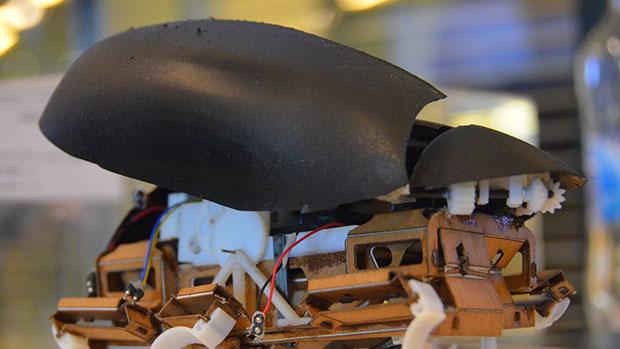SeoulNationalUniversity
Latest

Latest robot roach can leap like the real thing
Look away entomophobes: a collaboration between South Korea's Seoul National University and UC Berkeley has created an unholy robotic cockroach that can not only crawl around to gross you out, but can also jump a solid five feet in the air and then prop itself up and keep on walking.

Graphene-based patch can help monitor blood sugar levels
This see-through patch made of graphene and studded with gold isn't just a fashion accessory or temporary tattoo. It has the capability to monitor your blood sugar levels and deliver diabetes medication. The prototype, designed by Seoul National University assistant professor Dae-Hyeong Kim and a team of researchers, has sensors that can detect your temperature and the pH/chemical composition of your sweat. It then beams the data it collects to an accompanying smartphone app. If the system infers that you need medicine based on the state of your sweat, the app computes for the amount of medication (metformin for type II diabetes) you need. The patch's microneedle array then injects the right amount into your body.

ICYMI: Rogue wave detection, exo-glove and more
#fivemin-widget-blogsmith-image-127753{display:none;} .cke_show_borders #fivemin-widget-blogsmith-image-127753, #postcontentcontainer #fivemin-widget-blogsmith-image-127753{width:570px;display:block;} try{document.getElementById("fivemin-widget-blogsmith-image-127753").style.display="none";}catch(e){}Today on In Case You Missed It: Researchers at Seoul National University developed the Exo-Glove Poly, which can help wearer's perform difficult tasks like opening doors or grasping delicate objects. MIT built an algorithm to help detect rogue waves and warn sailors about them. And the Leidenfrost effect of a water droplet landing on a hot griddle and hovering above steam had never been captured on video, until now. We also covered a bunch of news in TL;DR but most urge you to dive into the latest on Apple vs. FBI, or for fun, read about what algae injections can do to vision. As always, please share any interesting science or tech videos, anytime! Just tweet us with the #ICYMI hashtag to @mskerryd.

Researchers create Meshworm robot, beat it up (video)
We've seen a number of options for controlling real worms, but never a worm robot, until now. Enter Meshworm, the latest creation from researchers at MIT, Harvard University and Seoul National University. The bot is made from "artificial muscle" composed of a flexible mesh tube segmented by loops of nickel / titanium wire. The wire contracts and squeezes the tube when heated by a flowing current, but cut the power and it returns to its original shape, creating propulsion in a similar way to its living kin. Taking traditional moving parts out of the equation also makes it pretty hardy, as proven by extensive testing (read: hitting it with a hammer). DARPA is known for getting its fingers in all sorts of strange pies, and it also supported this project. We can't see it being the fastest way of gathering intel, but the potential medical applications, such as next-gen endoscopes, sound plausible enough. Full impact tests in the video after the break.

Electronic skin lets machines sense water droplets and heartbeats, wonder why they were programmed to feel
A team of researchers at South Korea's Seoul National University have been busy developing biologically-inspired electronic skin that is capable of "feeling" subtle stimulus such as bouncing water droplets and human heartbeats. The skin's surface is covered in two interlocked arrays of 50-nanometre-wide polymeric nanofibres that act like hairs on the surface of the skin, coming in contact with one another under the strain of external force. That contact then generates a current to help the skin gauge the changes in pressure, according to New Scientist. The creators of the flexible skin say that sensor response can be repeated up to 10,000 cycles, displaying their output on a computer in real-time.

Genetically modified mongrel takes drugs, glows in the dark
Labradoodles, Cockapoos and Puggles better make way, there's a new designer breed lighting up the pound -- blacklight-style. Using the same somatic cell transfer technique that birthed the first puppy clone, Korean researchers at Seoul National University created Tegon, a glow-in-the-dark female beagle. The four years in the making, 3.2 billion won ($3 million) genetically modified pup fluoresces when exposed to UV light after ingesting a doxycycline antibiotic. No doubt this Frankenweenie should have Uptown girls and Party kids scrambling for a bank loan, but a high-end canine accessory end is not what the team had in mind. Citing the 268 diseases mutt and man share, lead scientist Lee Byeong-chun believes future lab-made pooches could include "genes that trigger fatal human diseases," paving the way for life-saving treatments. If any of this is ringing your PETA alarm, we don't blame you. We'd much rather see this lambent hooch take the starring role in Tim Burton's next, great reboot. [Image credit via Reuters]




